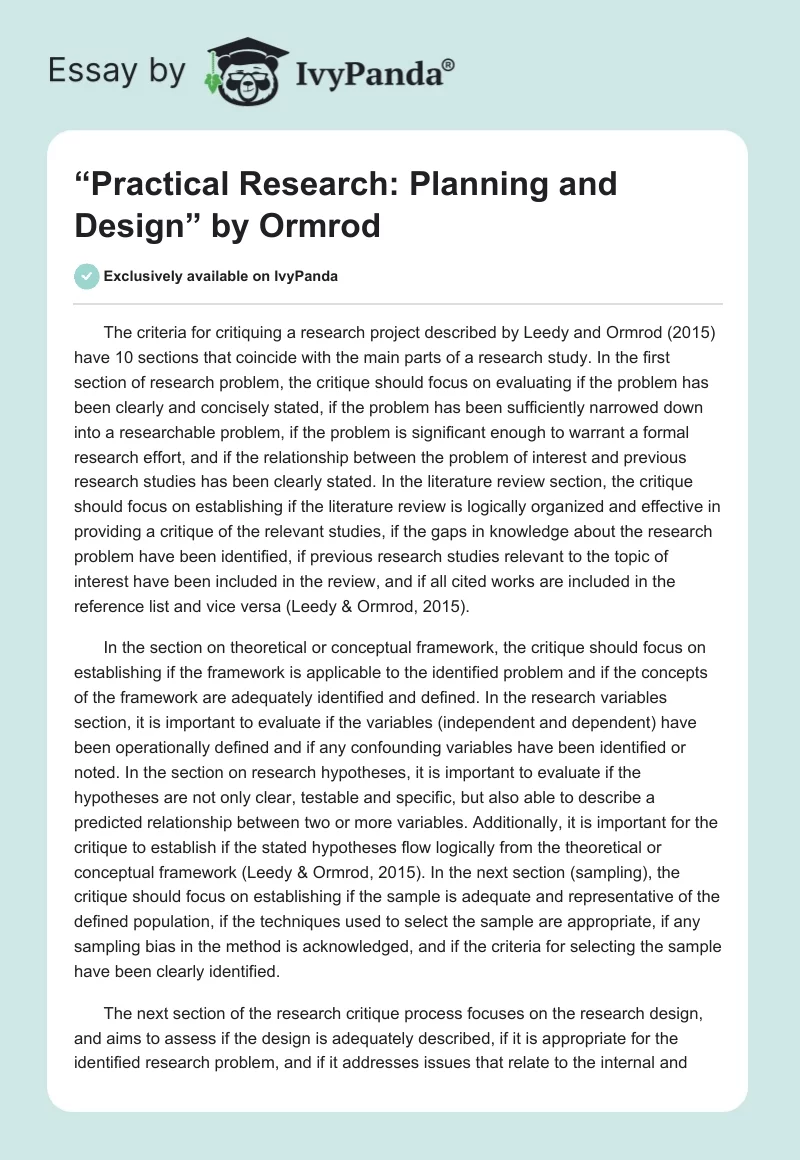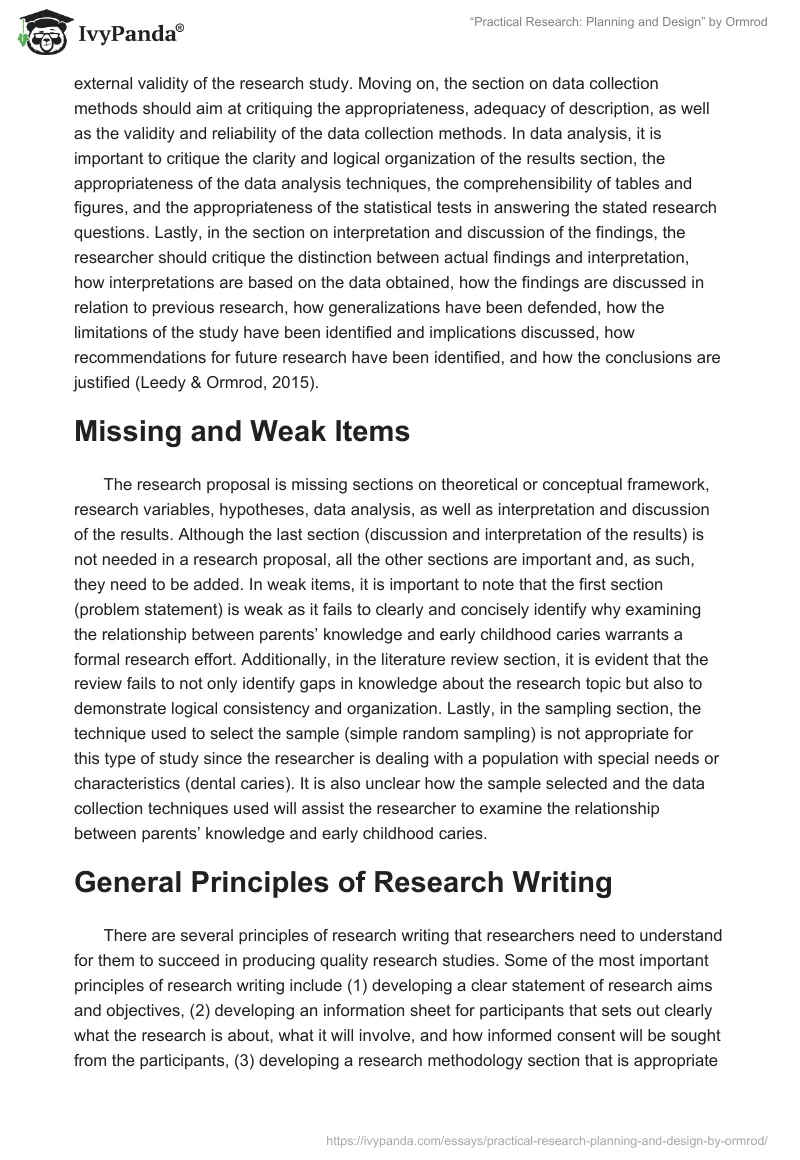The criteria for critiquing a research project described by Leedy and Ormrod (2015) have 10 sections that coincide with the main parts of a research study. In the first section of research problem, the critique should focus on evaluating if the problem has been clearly and concisely stated, if the problem has been sufficiently narrowed down into a researchable problem, if the problem is significant enough to warrant a formal research effort, and if the relationship between the problem of interest and previous research studies has been clearly stated. In the literature review section, the critique should focus on establishing if the literature review is logically organized and effective in providing a critique of the relevant studies, if the gaps in knowledge about the research problem have been identified, if previous research studies relevant to the topic of interest have been included in the review, and if all cited works are included in the reference list and vice versa (Leedy & Ormrod, 2015).
In the section on theoretical or conceptual framework, the critique should focus on establishing if the framework is applicable to the identified problem and if the concepts of the framework are adequately identified and defined. In the research variables section, it is important to evaluate if the variables (independent and dependent) have been operationally defined and if any confounding variables have been identified or noted. In the section on research hypotheses, it is important to evaluate if the hypotheses are not only clear, testable and specific, but also able to describe a predicted relationship between two or more variables. Additionally, it is important for the critique to establish if the stated hypotheses flow logically from the theoretical or conceptual framework (Leedy & Ormrod, 2015). In the next section (sampling), the critique should focus on establishing if the sample is adequate and representative of the defined population, if the techniques used to select the sample are appropriate, if any sampling bias in the method is acknowledged, and if the criteria for selecting the sample have been clearly identified.
The next section of the research critique process focuses on the research design, and aims to assess if the design is adequately described, if it is appropriate for the identified research problem, and if it addresses issues that relate to the internal and external validity of the research study. Moving on, the section on data collection methods should aim at critiquing the appropriateness, adequacy of description, as well as the validity and reliability of the data collection methods. In data analysis, it is important to critique the clarity and logical organization of the results section, the appropriateness of the data analysis techniques, the comprehensibility of tables and figures, and the appropriateness of the statistical tests in answering the stated research questions. Lastly, in the section on interpretation and discussion of the findings, the researcher should critique the distinction between actual findings and interpretation, how interpretations are based on the data obtained, how the findings are discussed in relation to previous research, how generalizations have been defended, how the limitations of the study have been identified and implications discussed, how recommendations for future research have been identified, and how the conclusions are justified (Leedy & Ormrod, 2015).
Missing and Weak Items
The research proposal is missing sections on theoretical or conceptual framework, research variables, hypotheses, data analysis, as well as interpretation and discussion of the results. Although the last section (discussion and interpretation of the results) is not needed in a research proposal, all the other sections are important and, as such, they need to be added. In weak items, it is important to note that the first section (problem statement) is weak as it fails to clearly and concisely identify why examining the relationship between parents’ knowledge and early childhood caries warrants a formal research effort. Additionally, in the literature review section, it is evident that the review fails to not only identify gaps in knowledge about the research topic but also to demonstrate logical consistency and organization. Lastly, in the sampling section, the technique used to select the sample (simple random sampling) is not appropriate for this type of study since the researcher is dealing with a population with special needs or characteristics (dental caries). It is also unclear how the sample selected and the data collection techniques used will assist the researcher to examine the relationship between parents’ knowledge and early childhood caries.
General Principles of Research Writing
There are several principles of research writing that researchers need to understand for them to succeed in producing quality research studies. Some of the most important principles of research writing include (1) developing a clear statement of research aims and objectives, (2) developing an information sheet for participants that sets out clearly what the research is about, what it will involve, and how informed consent will be sought from the participants, (3) developing a research methodology section that is appropriate to the research question and the study objectives, (4) carrying out the research process in an unbiased manner through the use of appropriate sampling strategies, and (5) ensuring that the research process has access to appropriate and sufficient resources in terms of people, time, transport, as well as money (Leedy & Ormrod, 2015; Principles of good research, 2006). It is also important for people undertaking the research to be adequately trained and for the professionals engaged in the research process to have a full understanding of the main subject area under study.
References
Leedy, P.D., & Ormrod, J.E. (2015). Practical research: Planning and design (11th ed.). Upper Saddle River, New Jersey: Pearson.
Principles of good research & research proposal guide. (2006). Web.


